The Lancashire witches


Lancashire has a certain notoriety among English counties for its witch trials. This is not altogether fair, as the counties of East Anglia saw many more trials, especially during the 1640s. The fame derives principally from two large trials in the early seventeenth century, and subsequent representations of them, especially the earlier one.
There had been earlier cases of note. One involved the mysterious death of the Earl of Derby in 1599, and another involved the notorious Puritan dispossesser, John Darrel. The 1612 case was unusual for England, however, because of the large number of accused involved.
On 18 March, 1612, Alizon Device was begging on the road to Trawden, near Colne. She met John Law, a pedlar, and asked him for some pins. He refused to give her the pins and she became angry with him. He had no sooner parted from her than he fell to the ground lame. Shortly after this she, her immediate family and some neighbours were arrested and questioned by Roger Nowell, the local magistrate and squire who lived in Read Hall. Some were released, some detained, and on 4 April Alizon, Demdike (her grandmother) and Chattox (a neighbour) were sent to Lancaster to await trial on a charge of witchcraft. On 10 April, Good Friday, a group of people, many known to be relatives and neighbours of those arrested, met at Malkin Tower, the home of Alizon Device and her family. On 27 April all those present at Malkin Tower on that day were arrested and questioned by Roger Nowell and other local magistrates.
On August 18 and 19, all were tried at the Assizes in
Lancaster, with Judge Bromley presiding, accompanied by Judge Altham. The
judges were assisted by Lord Gerard and Sir Richard Hoghton, a local baronet
and magistrate. The prosecutor, a former High Sheriff of Lancashire, was
the same Roger Nowell who had sent the accused for trial, and the Clerk
of the Court was
Thomas Potts of London. Most of what we know about
the trials of 1612 derives from the published account by Potts. On
20 August, ten, having been found guilty, were taken from the castle and
hanged.
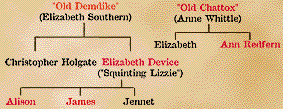
In all, 20 persons were brought to trial in August. They testified against each other. The principal witnesses were Elizabeth Device's children, Alison, James, who was in his twenties, and Jennet (also given as Jannet). Jennet said that Elizabeth had an imp named Ball, which she dispatched to murder anyone who displeased her. James said he had seen Ball in the shape of a brown dog and also had seen his mother making clay images. With the testimony of her children, Elizabeth then confessed. Jennet then implicated James, saying he used another imp in the shape of a dog, Dandy, to bewitch persons to death. James confessed. At the end of the three-day Assize, a total of 10 people were found guilty of witchcraft, sentenced to death and hanged on the moor above the town, at a place now known as "Golgotha". They were Anne Whittle ("Old Chattox"), Ann Redfearn, Elizabeth Device ("Squinting Lizzie"), Alice Nutter, Alison Device, James Device, Katherine Hewitt, Jane Bulcock, John Bulcock, and Isobel Robey. Margaret Pearson was not executed. Instead, she was sentenced to be pilloried on four consecutive market days in Padiham, Clitheroe, Whalley and Lancaster, and then to serve one year in prison. All of the Samlesbury witches were acquitted, as was Alice Grey. Another name, that of Jennet Preston, is often linked with this trial, but she had been hanged in York in July 1612 on the orders of the same judges who sat in Lancaster a month later. [Lancaster had a separate, palatinate jurisdiction, but it was served by the same judges who tried cases on the Northern Assize circuit.]

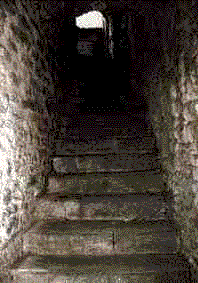 Felons
awaiting trial or execution in the English provinces were confined at the
prison in the county's assize town, where capital trials were held twice
a year. Here, we see the so-called Witches' Tower at Lancaster Castle
and the dungeon steps. Conditions were highly insanitary, as in other
prisons. One of the 1612 prisoners died before trial, and the 1634
witches also died in gaol. After the 1745 Jacobite Rebellion, there
was an outbreak of gaol fever (typhus) which killed many of those awaiting
trial.
Felons
awaiting trial or execution in the English provinces were confined at the
prison in the county's assize town, where capital trials were held twice
a year. Here, we see the so-called Witches' Tower at Lancaster Castle
and the dungeon steps. Conditions were highly insanitary, as in other
prisons. One of the 1612 prisoners died before trial, and the 1634
witches also died in gaol. After the 1745 Jacobite Rebellion, there
was an outbreak of gaol fever (typhus) which killed many of those awaiting
trial.
John Swain, an economic historian of the area around Pendle, has made a close study of the circumstances of the Lancashire witch trials of 1612 and 1634, which reveals that they did not coincide with periods of acute economic distress. The accused witches were almost exclusively from the poorest segment of society. They appear to be people who cultivated reputations for practising witchcraft in order to obtain work as healers or to facilitate the extortion of charity from fearful neighbours. Their long established reputations placed them in peril when their neighbours and the local authorities came to believe that black magic was being practised.
The fame of the Lancashire witches
Although their real fame is more modern, there were dramatic representations of the cases on the London stage in the seventeenth century. The Late Lancashire Witches was printed in 1634 as the joint work of Thomas Heywood and Richard Brome, but the story of the play was based, in part, upon the book that had been published by Thomas Potts in 1613. It is therefore possible that Heywood was the author of a play much earlier than that put on the stage in 1634, to cashi in on the second case, in which Edmund Robinson, the boy who was the principal witness, had been brought up to London, along with some of the accused. He confessed that his evidence before the Lancashire magistrates had been suborned, and the accused, unlike their unfortunate predecessors in 1612, were pardoned. A Restoration play on the subject, by Shadwell was rather more satirical in intent, being a sceptical attack on witch beliefs and Catholic superstition. [On the Heywood/Brome play and its context, see the article by Heather Hirschfield.]
Potts's book was rediscovered and republished in a collection of 'Scarce and Valuable Tracts' at the beginning of the nineteenth century. This series was edited and arranged by Sir Walter Scott, who had an antiquarian interest in Scottish witchcraft and who described the Discovery as a curious and rare book. However, the real revival of the Lancashire Witches' fame undoubtedly came halfway through the nineteenth century, and owed its beginnings to the friendship between James Crossley, the scholarly head of a Manchester historical society, and Harrison Ainsworth, a writer of historical novels. Crossley was president of the Chetham Society. This was founded at his home in 1843, and was subsequently responsible for the printing of many historical documents, including in 1845 The Discovery of Witches. Crossley was a solicitor, whose partner's son, Harrison Ainsworth, had deserted the law to find eventual fame as an author an rival of Charles Dickens. Ainsworth was already well established when his novel The Lancashire Witches was published in 1848, but his debt to his friend is acknowledged in his dedication, which introduces early editions of the book. Later books, both fiction and non-fiction, have perpetuated and increased the fame of the Lancashire trials, especially that of 1612.
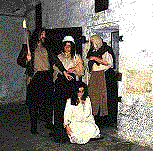
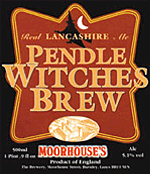


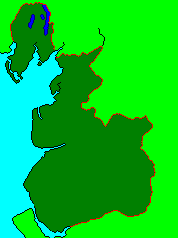
Bibliographical note
The Lancashire cases, especially those of 1612, are often mentioned in books on English witchcraft, such as those by Wallace Notestein, Keith Thomas, and James Sharpe, but there is no full-length treatment of the county, probably because of the shortage of source material.
John Webster, in his Displaying of Supposed Witchcraft, discusses Lancashire cases from 1612 and 1634, as examples of children giving false evidence.
The Trial of the Lancaster Witches - A.D. MDCXII, edited with an introduction by G. B. Harrison (London: Peter Davies, 1929) includes a transcript of The Wonderfull Discouerie of Witches in the Countie of Lancaster, by Thomas Potts, which records all the 1612 Lancaster witchcraft trials.
The Trials of the Lancashire Witches - A Study of Seventeenth Century Witchcraft, by Edgar Peel and Pat Southern, is a local historical study frequently reprinted since 1969.
J.T.Swain, "The Lancashire Witch Trials of 1612 and 1634, and the Economics of Witchcraft", Northern History 30 (1994) 64-85
"Witchcraft Accusations in Tudor-Stuart Lancashire", abstract of paper by Diana Lyn Laulainen-Schein [As far as I know, her project remains a work-in-progress.]
Poole, R. (ed.), The Lancashire Witch Trials, 1612 - 1999 (Manchester: Manchester University Press, 2002) [This seems not to have appeared as yet.]
On other parts of Northern England in this period, see
Peter Rushton, "Women, Witchcraft, and Slander in Early Modern England; Cases from the Church Courts of Durham, 1560-1675", Northern History 18 (1982) 116-132
J.A.Sharpe, "Witchcraft and Women in Seventeenth-Century England: Some Northern Evidence", Continuity and Change 6 (1991) 46-55